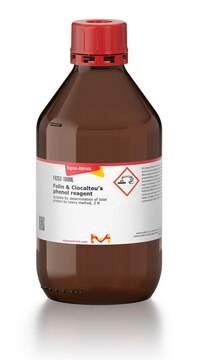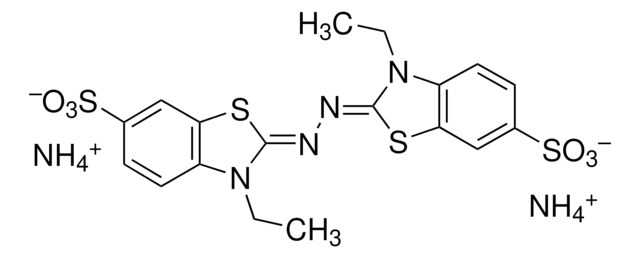534064
Aceton
histological grade, ≥99.5%
About This Item
Empfohlene Produkte
Qualität
histological grade
Qualitätsniveau
Dampfdichte
2 (vs air)
Dampfdruck
184 mmHg ( 20 °C)
Assay
≥99.5%
Form
liquid
Expl.-Gr.
13.2 %
Verunreinigungen
<0.5% water
Abdampfrückstand
<0.001%
Brechungsindex
n20/D 1.359 (lit.)
pH-Wert
5-6 (20 °C, 395 g/L)
bp
56 °C/760 mmHg (lit.)
mp (Schmelzpunkt)
−94 °C (lit.)
Löslichkeit
water: miscible
Dichte
0.791 g/mL at 25 °C (lit.)
Anwendung(en)
histology
Format
neat
SMILES String
CC(C)=O
InChI
1S/C3H6O/c1-3(2)4/h1-2H3
InChIKey
CSCPPACGZOOCGX-UHFFFAOYSA-N
Suchen Sie nach ähnlichen Produkten? Aufrufen Leitfaden zum Produktvergleich
Allgemeine Beschreibung
Anwendung
- As a precursor for the synthesis of methyl isobutyl ketone (MIBK) in the presence of sulfonated graphene oxide-Pd/cordierite catalyst.
- Synthesis of (4-hydroxymethyl-2,2-dimethyl-1,3-dioxolane), a solketal from glycerol using supercritical fluids (SCF) technology.
- As a starting material to synthesize methyl methacrylate.
- 1-isopropylidene-2-methylhydrazine
- 1-isopropylidene-2-hydroxyethylhydrazine
- 1-isopropylidene-2-formylhydrazine
Signalwort
Danger
H-Sätze
P-Sätze
Gefahreneinstufungen
Eye Irrit. 2 - Flam. Liq. 2 - STOT SE 3
Zielorgane
Central nervous system
Zusätzliche Gefahrenhinweise
Lagerklassenschlüssel
3 - Flammable liquids
WGK
WGK 1
Flammpunkt (°F)
1.4 °F - closed cup
Flammpunkt (°C)
-17.0 °C - closed cup
Analysenzertifikate (COA)
Suchen Sie nach Analysenzertifikate (COA), indem Sie die Lot-/Chargennummer des Produkts eingeben. Lot- und Chargennummern sind auf dem Produktetikett hinter den Wörtern ‘Lot’ oder ‘Batch’ (Lot oder Charge) zu finden.
Besitzen Sie dieses Produkt bereits?
In der Dokumentenbibliothek finden Sie die Dokumentation zu den Produkten, die Sie kürzlich erworben haben.
Kunden haben sich ebenfalls angesehen
Unser Team von Wissenschaftlern verfügt über Erfahrung in allen Forschungsbereichen einschließlich Life Science, Materialwissenschaften, chemischer Synthese, Chromatographie, Analytik und vielen mehr..
Setzen Sie sich mit dem technischen Dienst in Verbindung.






